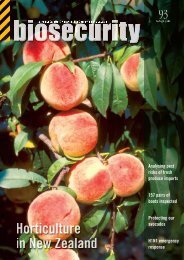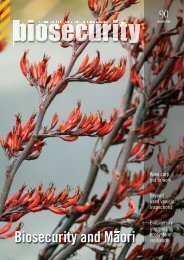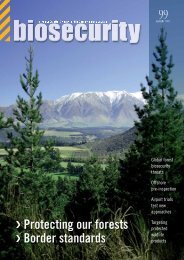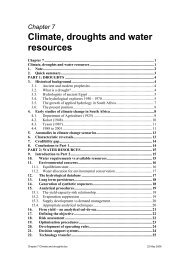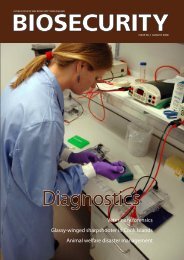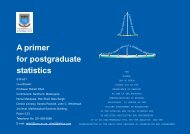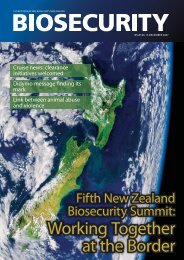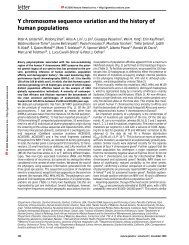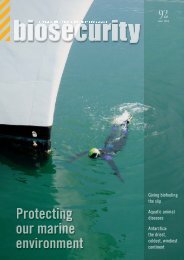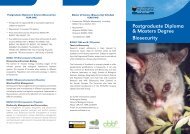The protection of biological diversity in South Africa: profiles and ...
The protection of biological diversity in South Africa: profiles and ...
The protection of biological diversity in South Africa: profiles and ...
Create successful ePaper yourself
Turn your PDF publications into a flip-book with our unique Google optimized e-Paper software.
S. Afr. J. Wildl. Res. 1995,25(2)<strong>The</strong> <strong>protection</strong> <strong>of</strong> <strong>biological</strong> <strong>diversity</strong> <strong>in</strong> <strong>South</strong> <strong>Africa</strong>: pr<strong>of</strong>iles <strong>and</strong> perceptions<strong>of</strong> pr<strong>of</strong>essional practitioners <strong>in</strong> nature conservation agencies <strong>and</strong>natural history museumsG.R. Preston*Environmental Evaluation Unit, University <strong>of</strong> Cape Town, Rondebosch, 7700 Republic <strong>of</strong> <strong>South</strong> <strong>Africa</strong>W.R. SiegfriedFitzPatrick Institute, University <strong>of</strong> Cape Town, Rondebosch, 7700 Republic <strong>of</strong> <strong>South</strong> <strong>Africa</strong>Two hundred pr<strong>of</strong>essional natural scientists (those with <strong>biological</strong> degrees) employed by <strong>of</strong>ficial nature conservationagencies (148 persons) <strong>and</strong> natural history museums (52 persons) <strong>in</strong> <strong>South</strong> <strong>Africa</strong> were surveyed for theirop<strong>in</strong>ions on matters affect<strong>in</strong>g the <strong>protection</strong> <strong>of</strong> <strong>biological</strong> <strong>diversity</strong> (= bio<strong>diversity</strong>). <strong>The</strong> respondents rated Freshwaterwetl<strong>and</strong>ecosystems as be<strong>in</strong>g most <strong>in</strong> need <strong>of</strong> special <strong>protection</strong> <strong>in</strong> <strong>South</strong> <strong>Africa</strong>. Terrestrial vascularplants were considered to be the group <strong>of</strong> wild alien species pos<strong>in</strong>g the greatest threat to <strong>in</strong>digenous bio<strong>diversity</strong>.Despite there be<strong>in</strong>g a broad range <strong>of</strong> specialized taxonomic knowledge amongst the scientists, relativelyfew <strong>of</strong> them have contributed to the compilation <strong>of</strong> species lists for nature reserves, or have published researchreports deal<strong>in</strong>g with aspects <strong>of</strong> bio<strong>diversity</strong>. <strong>The</strong> components <strong>of</strong> conservation biology for which the respondentsfelt most <strong>in</strong> need <strong>of</strong> additional tra<strong>in</strong><strong>in</strong>g were geographic <strong>in</strong>formation systems, mathematical modell<strong>in</strong>g, m<strong>in</strong>imumviable populations, time-series analysis <strong>and</strong> decision analysis. <strong>The</strong> respondents also expressed a greater needfor further tra<strong>in</strong><strong>in</strong>g <strong>in</strong> socio-economic <strong>in</strong>fluences <strong>and</strong> environmental impact assessments than for other options.Tweehonderd pr<strong>of</strong>essionele natuurwetenskaplikes (diegene met biologiese grade) <strong>in</strong> diens van amptelikenatuurbewar<strong>in</strong>gs<strong>in</strong>stansies (148 persone) en natuurhistoriese museums (52 persone) <strong>in</strong> Suid-Afrika het deeluitgemaak van 'n men<strong>in</strong>gsopname m.b.t. sake wat die beskerm<strong>in</strong>g van biologiese diversiteit (= biodiversiteit)bei'nvloed. Die proefpersone het Varswater/Vleil<strong>and</strong> ekosisteme geevalueer as die ekosisteme met die grootstebehoefte aan spesiale beskerm<strong>in</strong>g <strong>in</strong> Suid-Afrika. Terrestriele vaatplante is as die groep wilde uitheemse plantebeskou wat die grootste bedreig<strong>in</strong>g vir <strong>in</strong>heemse biodiversiteit <strong>in</strong>hou. Ten spyte van 'n wye spektrum van gespesialiseerdetaksonomiese kennis onder die wetenskaplikes, het betreklik m<strong>in</strong> van hulle 'n bydrae gemaak tot dieopstel van spesieslyste vir natuurreservate <strong>of</strong> navors<strong>in</strong>gsverslae m.b.t. aspekte van biodiversiteit gepubliseer.Die komponente van bewar<strong>in</strong>gsbiologie waarvoor die deelnemers die meeste nodigheid vir verdere opleid<strong>in</strong>g agis geografiese <strong>in</strong>ligt<strong>in</strong>gsisteme, wiskundige modeller<strong>in</strong>g, m<strong>in</strong>imum lewensvatbare bevolk<strong>in</strong>gs, tyd-reeksanaliseen besluitnem<strong>in</strong>gsanalise. Die proefpersone spreek ook 'n groter behoefte uit vir opleid<strong>in</strong>g <strong>in</strong> sosio-ekonomiese<strong>in</strong>vloede en omgew<strong>in</strong>gsimpakstudies as vir <strong>and</strong>er aspekte.Keywords: Bio<strong>diversity</strong> <strong>protection</strong>, co.nsenration biology ,tra<strong>in</strong><strong>in</strong>g, priority ecosystems, scientists' perceptions* To whom correspondence should be addressedIntroduction<strong>South</strong> <strong>Africa</strong> conta<strong>in</strong>s extraord<strong>in</strong>arily high levels <strong>of</strong> <strong>biological</strong><strong>diversity</strong> (= bio<strong>diversity</strong>), <strong>in</strong> terms <strong>of</strong> species richness <strong>and</strong>local endemism (Siegfried 1989). Hence, <strong>South</strong> <strong>Africa</strong> has animportant position <strong>and</strong> a practical role to play <strong>in</strong> the <strong>protection</strong><strong>of</strong> global bio<strong>diversity</strong>.Here we report on the results <strong>of</strong> part <strong>of</strong> an <strong>in</strong>vestigationdesigned to yield an overview <strong>of</strong> what is be<strong>in</strong>g done to promotethe <strong>protection</strong> <strong>of</strong> bio<strong>diversity</strong> <strong>in</strong> <strong>South</strong> <strong>Africa</strong>. More particularly,we focus on the biographical pr<strong>of</strong>iles <strong>and</strong>perceptions <strong>of</strong> a body <strong>of</strong> pr<strong>of</strong>essional natural scientists <strong>in</strong><strong>South</strong> <strong>Africa</strong>n <strong>of</strong>ficial nature conservation agencies <strong>and</strong> naturalhistory museums, scientists who are most concerned withthe <strong>protection</strong> <strong>of</strong> bio<strong>diversity</strong>. <strong>The</strong> data collection took threemonths, <strong>and</strong> was completed <strong>in</strong> January 1992.Methods<strong>South</strong> <strong>Africa</strong> is taken here to mean the Republic <strong>of</strong> <strong>South</strong><strong>Africa</strong>, <strong>in</strong>clud<strong>in</strong>g the now defunct so-called 'self-govern<strong>in</strong>g'or '<strong>in</strong>dependent' territories (see Siegfried 1989). <strong>South</strong>ern<strong>Africa</strong> is here taken to mean <strong>South</strong> <strong>Africa</strong> (as def<strong>in</strong>ed above),Lesotho, Swazil<strong>and</strong>, Botswana, Namibia <strong>and</strong> the sea (<strong>in</strong>clud<strong>in</strong>g<strong>of</strong>f-shore isl<strong>and</strong>s) with<strong>in</strong> 200 km <strong>of</strong> the shore. Zimbabwe,Angola <strong>and</strong> Mozambique are not <strong>in</strong>cluded. <strong>The</strong> term, 'naturereserve' has been used to encompass national parks <strong>and</strong> protectedareas.A questionnaire form was drawn up <strong>in</strong> consultation withprom<strong>in</strong>ent conservation biologists (see Acknowledgementssection). Copies <strong>of</strong> the form (<strong>in</strong> English <strong>and</strong> Afrikaans) weresent to the directors <strong>of</strong> the 16 <strong>of</strong>ficial (public sector) natureconservation agencies <strong>and</strong> the 13 natural history museums <strong>in</strong><strong>South</strong> <strong>Africa</strong>, request<strong>in</strong>g that they ask their pr<strong>of</strong>essional staffs<strong>of</strong> scientists hold<strong>in</strong>g <strong>biological</strong> degrees from universities torespond. <strong>The</strong> difficulty <strong>of</strong> identify<strong>in</strong>g academic biologists<strong>in</strong>volved <strong>in</strong> state-funded bio<strong>diversity</strong> research led to theirbe<strong>in</strong>g excluded from this study.<strong>The</strong> questionnaire conta<strong>in</strong>ed a section devoted to a biographicalpr<strong>of</strong>ile, but focused on the respondents' perceptions<strong>and</strong> qualifications relat<strong>in</strong>g to: natural systems most <strong>in</strong> need <strong>of</strong>bio<strong>diversity</strong> <strong>protection</strong>; alien threats to <strong>in</strong>digenous bio<strong>diversity</strong>;taxonomic knowledge; contributions to species lists; scientificjournals read most frequently; reference works usedmost frequently; recommended publications on bio<strong>diversity</strong>;expertise <strong>and</strong> tra<strong>in</strong><strong>in</strong>g needs <strong>in</strong> components <strong>of</strong> conservationbiology <strong>and</strong> environmental science; reactions to two issuesaris<strong>in</strong>g out <strong>of</strong> conservation biology; <strong>and</strong> actions necessary topromote bio<strong>diversity</strong> <strong>protection</strong> <strong>in</strong> <strong>South</strong> <strong>Africa</strong>.
S. Afr. J. Wildl. Res. 1995, 25(2)<strong>The</strong> data takes the form <strong>of</strong> frequencies arranged <strong>in</strong> categories.Normality cannot be assumed, <strong>and</strong> it is consequentlynecessary to use a non-parametric test. <strong>The</strong> chi-square test hasbeen used when look<strong>in</strong>g to establish statistical significance.Results <strong>and</strong> DiscussionTwo hundred scientists (148 <strong>and</strong> 52 <strong>in</strong> nature conservationagencies <strong>and</strong> natural history museums, respectively)responded to the questionnaire before the cut-<strong>of</strong>f date for statisticalanalysis <strong>of</strong> the results presented at the IUCN's IVWorld Congress on National Parks <strong>and</strong> Protected Areas, held<strong>in</strong> Caracas, Venezuela, <strong>in</strong> February 1992. Calculat<strong>in</strong>g aresponse rate is problematical, because certa<strong>in</strong> <strong>of</strong> the directors<strong>of</strong> <strong>in</strong>stitutions restricted the recipients <strong>of</strong> questionnaires tothose scientists <strong>in</strong>volved <strong>in</strong> research (by omitt<strong>in</strong>g, for example,those <strong>in</strong> adm<strong>in</strong>istrative positions, even if they had theappropriate academic qualifications for participation). Moreover,a suite <strong>of</strong> three questions ask<strong>in</strong>g respondents to reporttheir unaided taxonomic knowledge, probably affected thereturns. Several recipients felt that these questions could serveto disparage them <strong>and</strong> they were unhappy about answer<strong>in</strong>gthem. <strong>The</strong> overall response rate is estimated to be over 70% <strong>of</strong>the total body <strong>of</strong> scientists surveyed.Biographical pr<strong>of</strong>ileMost (87%) <strong>of</strong> the respondents were males. This genderimbalance may be typical <strong>of</strong> groups <strong>of</strong> scientists <strong>in</strong> similar<strong>in</strong>stitutions <strong>in</strong> many parts <strong>of</strong> the world. Similarly, the languagesplit (64% English speak<strong>in</strong>g) does not reflect thenational pr<strong>of</strong>ile. Less than 10% <strong>of</strong> all <strong>South</strong> <strong>Africa</strong>ns haveEnglish as a home language (based on data from the <strong>South</strong><strong>Africa</strong>n Central Statistical Services, 1992).<strong>The</strong> mean (<strong>and</strong> median) age <strong>of</strong> the respondents was 40years, with a range between 24 <strong>and</strong> 78 years. Respondentshad a mean <strong>of</strong> 12 years <strong>of</strong> employment <strong>in</strong> nature conservationagencieslnatural history museums, with a median period <strong>of</strong>n<strong>in</strong>e years <strong>and</strong> a range between 0 <strong>and</strong> 48 years. Personal communicationwith most <strong>of</strong> the directors <strong>of</strong> the <strong>in</strong>stitutions concernedsuggested that turnover <strong>of</strong> staff is low (despiterelatively poor salaries, there is a great deal <strong>of</strong> prestige <strong>and</strong>job satisfaction), <strong>and</strong> that an <strong>in</strong>crease <strong>in</strong> the number <strong>of</strong> postsdevoted to scientific services had occurred <strong>in</strong> recent years.<strong>The</strong>re is, thus, a relatively large amount <strong>of</strong> mature experienceunderp<strong>in</strong>n<strong>in</strong>g the scientific services <strong>of</strong> these <strong>in</strong>stitutions.<strong>The</strong> personal education levels were correspond<strong>in</strong>gly high.It is remarkable that 93% <strong>of</strong> the respondents have a post-graduatequalification: 38% <strong>and</strong> 31% <strong>of</strong> the respondents hav<strong>in</strong>gdoctoral or masters degrees, respectively. This confirms thehigh academic st<strong>and</strong>ards required to obta<strong>in</strong> employment <strong>in</strong>these <strong>in</strong>stitutions. <strong>The</strong> respondents' highest qualificationswere obta<strong>in</strong>ed an average <strong>of</strong> 10 years ago, although 21% hadobta<strong>in</strong>ed their highest degree <strong>in</strong> the last three years. <strong>The</strong> Universities<strong>of</strong> Pretoria (24%), Natal (16%), Cape Town (1 I%),Witwatersr<strong>and</strong> (9%) <strong>and</strong> Stellenbosch (9%) conferred most <strong>of</strong>these degrees, with 11% be<strong>in</strong>g conferred by overseas universities.Of the respondents, 57% extended their pr<strong>of</strong>essional<strong>in</strong>terests by be<strong>in</strong>g voluntary members <strong>of</strong> conservation societies.Respondeilts were asked where they would place themselveson a five-po<strong>in</strong>t generalist-ecologist to specialist-scien-tist cont<strong>in</strong>uum. <strong>The</strong>re was a fairly even spread across thecont<strong>in</strong>uum, with a slight shift to the specialist side (36% sawthemselves to be on the generalist-ecologist side, 22% <strong>in</strong> themiddle, <strong>and</strong> 42% on the specialist-scientist side). Most <strong>of</strong> themuseum scientists were on the specialist-scientist side,whereas more scientists from the nature conservation agencieswere on the generalist-ecologist side. Given the range <strong>of</strong>requirements <strong>of</strong> nature reserve staff, <strong>and</strong> the known specialist<strong>in</strong>cl<strong>in</strong>ations <strong>of</strong> museum staff, this appears to be a well-balancedspread <strong>of</strong> expertise.Most <strong>of</strong> the respondents were employed <strong>in</strong> research positions(71%), or <strong>in</strong> the adm<strong>in</strong>istration <strong>of</strong> research. Of therespondents, 17% worked for the Sea Fisheries ResearchInstitute <strong>of</strong> the Department <strong>of</strong> Environment Affairs; 15% forthe National Parks Board; 30% for the four (former) prov<strong>in</strong>cial(Cape, Natal, Orange Free State, Transvaal) nature conservationagencies; 12% for (former) 'homel<strong>and</strong>'l'<strong>in</strong>dependentstate' conservation agencies, <strong>and</strong> 26% for museums(<strong>in</strong>clud<strong>in</strong>g 7% for the National Botanical Institute).Only 13% <strong>of</strong> the respondents had attended an <strong>in</strong>ternational(here taken to mean outside southern <strong>Africa</strong>) conference specificallydeal<strong>in</strong>g with bio<strong>diversity</strong> dur<strong>in</strong>g the last five years.Of these, 2% had attended two such conferences. Of therespondents, 45% had attended local conferences deal<strong>in</strong>gwith bio<strong>diversity</strong> (21% <strong>of</strong> these hav<strong>in</strong>g attended more thanone conference on the subject). This is, <strong>in</strong> part, a reflection <strong>of</strong>the limited number <strong>of</strong> conferences deal<strong>in</strong>g with bio<strong>diversity</strong>that have been held <strong>in</strong> southern <strong>Africa</strong> dur<strong>in</strong>g the last fiveyears.What is more surpris<strong>in</strong>g is that only 14% <strong>of</strong> the respondentshave had one or more scientific publications on bio<strong>diversity</strong>published <strong>in</strong> refereed journals dur<strong>in</strong>g the last five years.Of the respondents, 10% have had a popular publication onbio<strong>diversity</strong> published dur<strong>in</strong>g this period. It may be an <strong>in</strong>dicationthat this subject is not the specific focus <strong>of</strong> most <strong>of</strong> theresearch undertaken by the scientists. (However, it should beborne <strong>in</strong> m<strong>in</strong>d that the scientists may have been produc<strong>in</strong>gunpublished reports on aspects <strong>of</strong> bio<strong>diversity</strong>. Furthermore,the difficulty <strong>of</strong> separat<strong>in</strong>g a bio<strong>diversity</strong> component frommore general nature conservation publications must beacknowledged.)Of the respondents, 39% did not <strong>in</strong>dicate that they had hadany scientific papers published dur<strong>in</strong>g the past five years.(<strong>The</strong> mean number <strong>of</strong> refereed papers by the respondents thatwere published dur<strong>in</strong>g this period is 4,35, which translates to7,13 for the 61% who had at least one paper published dur<strong>in</strong>gthis period.) Even fewer respondents (46%) had had one ormore popular articles published dur<strong>in</strong>g this period.More respondents (43%) work <strong>in</strong> the Savanna system thanany other, consistent with the popularity <strong>of</strong> 'big-game' naturereserves for tourists. Grassl<strong>and</strong>, too, is well served (33%),whereas Fynbos - arguably, on an <strong>in</strong>ternational scale, <strong>South</strong><strong>Africa</strong>'s most important bio<strong>diversity</strong> biome - languishes atthe bottom (only 9% work<strong>in</strong>g <strong>in</strong> the system). This is likely tobe a reflection <strong>of</strong> the fact that most <strong>of</strong> the first <strong>and</strong> biggestnature reserves were established to conserve big game, <strong>and</strong>this legacy still means that there are imbalances <strong>in</strong> the distribution<strong>of</strong> the scientists work<strong>in</strong>g for nature conservation agencies.(See Table 1 for list <strong>of</strong> biomes <strong>and</strong> biotopes.)
S. Afr. J. Wildl. Res. 1995,25(2) 5 1Biotic systems most <strong>in</strong> need <strong>of</strong> additional <strong>protection</strong>Based on previous experience (e.g. Breen & Begg 1989; Siegfried1989), it was expected that, among the biomes <strong>and</strong>biotopes, Fresh-waterlwetl<strong>and</strong>s would be given the highestrat<strong>in</strong>g, followed by the Karoo biome. <strong>The</strong> Karoo biome hasbeen identified repeatedly as the richest centre for endemictaxa <strong>of</strong> several vertebrate classes, taxa which are not represented<strong>in</strong> the region's nature reserve system (Siegfried 1989,1992; Siegfried & Brown 1992). Straddl<strong>in</strong>g the list <strong>of</strong> biomesTable 1 Need for bio<strong>diversity</strong> preservation <strong>in</strong> ecologicalsystems <strong>in</strong> <strong>South</strong>ern <strong>Africa</strong>Question 2 - How important do you consider the follow<strong>in</strong>g systems to be forbio<strong>diversity</strong> preservation action? Please rate each on a scale <strong>of</strong> 0 to 10, where10110 means that this system is critically <strong>in</strong> need <strong>of</strong> bio<strong>diversity</strong> preservationaction, while 0110 means that sufficient action to preserve bio<strong>diversity</strong> <strong>in</strong> thesystem is be<strong>in</strong>g taken. Please leave blank those systems that you feel youcannot rate.Which one system do you consider to be most <strong>in</strong> need <strong>of</strong> bio<strong>diversity</strong>preservation action?[Note: n = 176 <strong>in</strong> column titled 'Most'.]Ib: Rat<strong>in</strong>gs by thosewho work, or havela: Rat<strong>in</strong>gs by all respondents worked, <strong>in</strong> each systemSystem Mean Most n Mean nFresh waterlwetl<strong>and</strong>s 8,96 38 164 9,03 92Estuariestlagoons 8,51 14 153 8,41 44Forest 7,73 13 146 7,63 62Fynbos 7,72 13 !30 7,15 30Beachesldunes 7,14 5 127 6,31 33Grassl<strong>and</strong> 7,06 14 137 6,82 65Rocky shores 6,44 1 116 5,44 34Karoo 6,39 2 115 6,65 48Montane 6,16 0 118 6,16 56Mar<strong>in</strong>e 6,11 1 121 4,98 51Savanna 5,26 1 130 521 11 1Desert 4,91 1 105 4,27 37<strong>The</strong> first three columns (la) refer to the mean rat<strong>in</strong>gs by all 200 respondents.<strong>The</strong> last two columns (Ib) give the mean rat<strong>in</strong>gs by those respondents whowork, or have worked, <strong>in</strong> the system <strong>in</strong> question.<strong>and</strong> biotopes, the <strong>South</strong> <strong>Africa</strong>n montane grassl<strong>and</strong>s <strong>and</strong> theirassociated wetl<strong>and</strong>s are be<strong>in</strong>g transformed extensively as aconsequence <strong>of</strong> a rapid expansion <strong>of</strong> commercial forestry.<strong>The</strong> high rat<strong>in</strong>g obta<strong>in</strong>ed for Fresh-watermetl<strong>and</strong>s <strong>in</strong> thesurvey (Table 1) agrees with the preced<strong>in</strong>g expectation, butthe relatively low rat<strong>in</strong>gs given to Montane, Grassl<strong>and</strong> <strong>and</strong>especially Karoo elements do not. Also at variance is the highrat<strong>in</strong>g given to the Forest biome, probably the best protectedsystem <strong>in</strong> the <strong>South</strong> <strong>Africa</strong>n nature reserve system (Siegfried1989). <strong>The</strong> Savanna system is also well protected by thenature reserve system <strong>and</strong>, as expected, it features low down<strong>in</strong> the respondents' rat<strong>in</strong>gs. Curiously, these rat<strong>in</strong>gs are verysimilar to the rat<strong>in</strong>gs for humid tropical Indonesia (Pr<strong>in</strong>s &W<strong>in</strong>d 1993).When asked which one particular system they consideredto be most <strong>in</strong> need <strong>of</strong> additional <strong>protection</strong>, the respondentsrated Fresh-watermetl<strong>and</strong>s (38%) well ahead <strong>of</strong> any othersystem. Estuaries/Lagoons (14%), Grassl<strong>and</strong> (14%), Forest(13%) <strong>and</strong> Fynbos (13%) were the only other systems toattract substantial support. <strong>The</strong> Karoo system was mentionedby only 2% <strong>of</strong> the respondents, whereas the Montane systemwas not mentioned by any respondent.A cross-tabulation <strong>of</strong> the mean rat<strong>in</strong>gs <strong>of</strong> the biotic systemsmost <strong>in</strong> need <strong>of</strong> <strong>protection</strong> by those scientists who work, orhave worked, <strong>in</strong> each system is presented <strong>in</strong> Table 2. Thosewho work, or have worked, <strong>in</strong> a system typically rate the needfor <strong>protection</strong> <strong>of</strong> that system as lower than do those who havenot worked <strong>in</strong> the system. This is particularly true <strong>of</strong> thosewho worklhave worked <strong>in</strong> the Mar<strong>in</strong>e, Rocky Shores <strong>and</strong>BeachesIDunes systems, while the exceptions to this tendencyare those who worklhave worked <strong>in</strong> the Karoo, Freshwatermetl<strong>and</strong>s<strong>and</strong> Montane systems. It is difficult to specu- -late on this tendency to rate less familiar biomes as be<strong>in</strong>gmore <strong>in</strong> need <strong>of</strong> additional <strong>protection</strong>. It may be <strong>in</strong>fluenced bypopular articles <strong>and</strong> programmes on these systems, whichmight accentuate perceptions <strong>of</strong> problems - as opposed tothe <strong>in</strong>fluence <strong>of</strong> outside op<strong>in</strong>ion on their perceptions <strong>of</strong> thesystems <strong>in</strong> which they work.<strong>The</strong> rat<strong>in</strong>gs <strong>of</strong> systems by those who work, or have worked,<strong>in</strong> the system thus show a different sequence to the overall rat<strong>in</strong>gs- Grassl<strong>and</strong> leap-frogs over BeachesIDunes systems;Karoo <strong>and</strong> Montane systems overtake Rocky Shores, <strong>and</strong>Savanna edges <strong>in</strong> front <strong>of</strong> Mar<strong>in</strong>e systems. With the exception<strong>of</strong> the last-mentioned change, the differences are statis!icallyTable 2 Alien threats to bio<strong>diversity</strong> <strong>in</strong> <strong>South</strong>ern <strong>Africa</strong>Question 3 -Which <strong>of</strong> the follow<strong>in</strong>g groups <strong>of</strong> wild alien species would you say pose the greatest threat to bio<strong>diversity</strong>. Please rate each group <strong>of</strong> alienspecies on a scale <strong>of</strong> 0 to 10, where 10110 means that this group is hav<strong>in</strong>g a critical impact, <strong>and</strong> 0110 means it is hav<strong>in</strong>g no negative impact, onbio<strong>diversity</strong> <strong>in</strong> <strong>South</strong>ern <strong>Africa</strong>. Note that the figures are percentages (e.g. 40% <strong>of</strong> the respondents gave Terrestrial vascular plants a rat<strong>in</strong>g <strong>of</strong> 10110).System Mean 10 9 8 7 6 5 4 3 2 1 0 nTerrestrial vascular plants 8,17 40 12 20 11 8 3 1 3 1 2 1 179Aquatic vascular plants 6,36 10 5 25 11 13 17 8 4 3 1 3 158Aquatic vertebrates 5,30 7 6 13 12 11 17 6 8 9 6 6 162Aquatic non-vascular plants 4,79 6 1. 9 10 13 15 13 9 15 5 4 128Terrestrial <strong>in</strong>vertebrates 4,62 4 1 9 8 13 20 14 8 15 4 5 144Terrestrial vertebrates 4,58 8 3 6 7 9 16 11 13 18 8 3 160Aquatic <strong>in</strong>vertebrates 4,22 2 1 8 8 11 17 13 8 17 8 7 143Terrestrial non-vascular plants 4.08 6 2 10 ' 6 7 11 12 12 16 9 11 122
'52 S. Afr. J. Wildl. Res. 1995, 25(2)significant (p < 0,005).<strong>The</strong> greatest variation <strong>in</strong> the respondents' perceptions <strong>of</strong>the need for <strong>protection</strong> by system were for the Grassl<strong>and</strong>,Montane, Desert, Rocky Shores <strong>and</strong> Mar<strong>in</strong>e systems.Respondents who workhave worked <strong>in</strong> BeachesIDunes,Rocky Shores, Mar<strong>in</strong>e, EstuariesILagoons, Fynbos, Karoo<strong>and</strong> Grassl<strong>and</strong> systems were more at variance with the overallrat<strong>in</strong>gs than those who workhave worked <strong>in</strong> the other systems.<strong>The</strong> rat<strong>in</strong>gs <strong>in</strong> Part B <strong>of</strong> Table 2 thus tend to support theauthors' contention that the overall (Part A <strong>of</strong> Table 1) rat<strong>in</strong>gsgiven to Montane, Grassl<strong>and</strong> <strong>and</strong> especially Karoo systemsare an under-estimation, relative to the rat<strong>in</strong>gs <strong>of</strong> the othersystems listed.Alien threats to bio<strong>diversity</strong><strong>The</strong> respondents' rat<strong>in</strong>g <strong>of</strong> wild alien species pos<strong>in</strong>g thegreatest threat to bio<strong>diversity</strong> accorded with the op<strong>in</strong>ion <strong>of</strong>Macdonald (1989). Terrestrial Vascular Plants were seen to bethe most significant alien <strong>in</strong>vaders, followed by Aquatic VascularPlants <strong>and</strong> Aquatic Vertebrates (Table 3). <strong>The</strong> category<strong>of</strong> Terrestrial Vertebrates was somewhat problematical, s<strong>in</strong>cesome respondents appear to have <strong>in</strong>cluded domestic livestock<strong>in</strong> the def<strong>in</strong>ition, despite the question referr<strong>in</strong>g to 'wild' <strong>in</strong>vasivealiens. Other respondents may not have thought <strong>of</strong><strong>in</strong>clud<strong>in</strong>g translocated natives <strong>in</strong> this category, such as thenyala Tragelaphus angasii reduc<strong>in</strong>g understory vegetation<strong>and</strong>, consequently, impact<strong>in</strong>g blue duiker Cephalophus monticolapopulations (Howard & Marchant 1984).<strong>The</strong> very high mean score (8,17110) given to TerrestrialVascular Plants is an <strong>in</strong>dication <strong>of</strong> the seriousness with whichthe scientists viewed the impact that these <strong>in</strong>vasive aliens arehav<strong>in</strong>g on bio<strong>diversity</strong> <strong>in</strong> the region. It raises the question <strong>of</strong>whether sufficient emphasis is be<strong>in</strong>g given to the control <strong>of</strong><strong>in</strong>vasive aliens by the authorities (see Richardson et al. 1992).Respondents' taxonomic knowledgeRespondents were asked to <strong>in</strong>dicate how many species <strong>in</strong> variousgroups <strong>of</strong> <strong>in</strong>digenous plants <strong>and</strong> animals they were ableto identify without reference books <strong>and</strong>lor museum specimens(Appendix 1 <strong>and</strong> 2). We had hoped to get a benchmarkby which we could measure over time any changes <strong>in</strong> taxonomicknowledge, <strong>and</strong> any changes <strong>in</strong> emphasis betweenthese groups <strong>of</strong> <strong>in</strong>digenous plants <strong>and</strong> animals.A number <strong>of</strong> respondents were critical <strong>of</strong> the question,.f<strong>in</strong>d<strong>in</strong>g it difficult to estimate the number <strong>of</strong> species by groupthat they could identify unaided. (It was clear from theanswers that certa<strong>in</strong> respondents made no attempt to answerthe question <strong>in</strong> full, thereby compromis<strong>in</strong>g the results.) Othersquestioned whether scientists should try to identify specimenswithout reference books <strong>and</strong>or museum species. In truth, theresults are not particularly <strong>in</strong>formative. Perhaps the mostimportant aspects are that:- there is a depth <strong>of</strong> expertise that exists with<strong>in</strong> most <strong>of</strong> theorganizations <strong>in</strong> the identification <strong>of</strong> higher-order animals;- there is a discernible emphasis on mammals (<strong>and</strong> mostparticularly ungulates <strong>and</strong> carnivores), birds <strong>and</strong> tortoises -perhaps to be expected, s<strong>in</strong>ce they are relatively easy to identify,<strong>and</strong> tourist dem<strong>and</strong>s would exacerbate this tendency;- it appears that more <strong>of</strong> the respondents are comfortablewith the unaided identification <strong>of</strong> species <strong>of</strong> animals than withspecies <strong>of</strong> plants - perhaps <strong>in</strong>dicative <strong>of</strong> a bias <strong>in</strong> favour <strong>of</strong>animals <strong>in</strong> the appo<strong>in</strong>tment <strong>of</strong> scientists to the <strong>in</strong>stitutionsconcerned (bear<strong>in</strong>g <strong>in</strong> m<strong>in</strong>d, too, that the plant-specific l<strong>in</strong>e <strong>of</strong>work <strong>of</strong> the National Botanical Institute would strongly boostthe overall averages for recognition <strong>of</strong> plant species).Respondents' contributions to species lists for naturereservesGiven the level <strong>of</strong> taxonomic knowledge with<strong>in</strong> the natureconservation agencies <strong>and</strong> natural history museums, the relativelylow contributions to species lists for nature reserves bythe respondents is surpris<strong>in</strong>g. Of the respondents, 13% havebeen responsible for one or more species lists for Birds; 12%for both Mammals <strong>and</strong> Plants, followed by Reptiles (8%),Amphibians (7% ), Fishes (5%) <strong>and</strong> Invertebrates (5%). Ofthe respondents, 31% have contributed towards one or morespecies lists for Plants, 27% for Birds, 24% for Mammals,followed by Reptiles (14% ), Amphibians (12% ), Invertebrates(1 1%) <strong>and</strong> Fishes (10%). To put this <strong>in</strong>to perspective,Siegfried (1989) found that <strong>South</strong> <strong>Africa</strong> (as def<strong>in</strong>ed here) has576 publicly-owned nature reserves, as well as many privatenature reserves. It would appear that this is an aspect wheremore might be done, s<strong>in</strong>ce the stronger the <strong>in</strong>ventory the betterthe options for reserve management. What was not asked<strong>of</strong> respondents was their contributions to the bird <strong>and</strong> otheratlases that are now be<strong>in</strong>g developed <strong>in</strong> southern <strong>Africa</strong> (e.g.Harrison 1989).Scientific journals read most thoroughlyOf the respondents, 9% said that the <strong>South</strong> <strong>Africa</strong>n Journal <strong>of</strong>Wildlife Research is the journal that they read most thoroughly,followed by the <strong>South</strong> <strong>Africa</strong>n Journal <strong>of</strong> Mar<strong>in</strong>e Science(8%). Koedoe (7%) the research journal <strong>of</strong> the NationalParks Board <strong>of</strong> <strong>South</strong> <strong>Africa</strong>, <strong>South</strong> <strong>Africa</strong>n Journal <strong>of</strong> Botany(6%) <strong>and</strong> Journal <strong>of</strong> the Grassl<strong>and</strong> Society (6%). Thirtyrespondents did not answer the question, <strong>and</strong> the rema<strong>in</strong><strong>in</strong>g85% named a total <strong>of</strong> 61 different journals. Two aspectsshould be noted: first, the choice <strong>of</strong> journals is parochial; secondly,one should consider publish<strong>in</strong>g <strong>in</strong> the aforego<strong>in</strong>g journalswhen want<strong>in</strong>g to communicate with the group <strong>of</strong>scientists <strong>in</strong>volved <strong>in</strong> this survey. Moreover, given the prom<strong>in</strong>enceaccorded to the <strong>South</strong> <strong>Africa</strong>n Journal <strong>of</strong> WildlifeResearch, it is remarkable that this journal publishes almostnoth<strong>in</strong>g deal<strong>in</strong>g primarily with the proteclion <strong>of</strong> bio<strong>diversity</strong>(see Siegfried & Brooke, MS.). Among the respondents whodo read the literature, it is remarkable how few read BiologicalConservation (5%) <strong>and</strong> Conservation Biology (1%) whichare <strong>in</strong> the forefront <strong>of</strong> the modern literature deal<strong>in</strong>g with the<strong>protection</strong> <strong>of</strong> bio<strong>diversity</strong>.Reference works used most frequently<strong>The</strong> three reference works most frequently used by therespondents were Smithers (1983) on mammals (24% <strong>of</strong> therespondents), Maclean (1985) on birds (17%) <strong>and</strong> Palgrave(1983) on trees (16%). <strong>The</strong>se works were followed, after agap, by Smith & Heemstra (1986) on mar<strong>in</strong>e fishes (7%), Zar(1984) on statistics (O%), Gibbs Russell et al. (1990) ongrasses (6%) <strong>and</strong> Scholtz & Holm (1985) on <strong>in</strong>sects (5%).In total, 235 reference works were mentioned by the 200
S. Afr. J. Wildl. Res. 1995, 25(2)respondents. <strong>The</strong> prom<strong>in</strong>ence <strong>of</strong> works <strong>of</strong> identification withsummaries <strong>of</strong> <strong>biological</strong> knowledge <strong>in</strong>dicates that bio<strong>diversity</strong>considerations are a component <strong>of</strong> the day-to-day work <strong>of</strong>these pr<strong>of</strong>essional scientists. Works with specific reference toplants, too, are prom<strong>in</strong>ent. This may <strong>in</strong>dicate the respondents'greater familiarity with animals that emerges from earlierquestions, <strong>and</strong> a greater need to consult books with a specialreference to plants.It is noteworthy that the book Biotic Diversity <strong>in</strong> <strong>South</strong>ern<strong>Africa</strong> (Huntley 1989), the product <strong>of</strong> the country's first symposiumon bio<strong>diversity</strong>, is mentioned by only 1% <strong>of</strong> therespondents. It is also <strong>of</strong> <strong>in</strong>terest that Fuggle & Rabie's (1985)Environmental Concerns <strong>in</strong> <strong>South</strong> <strong>Africa</strong>, a holistic perspective<strong>of</strong> broad environmental issues <strong>in</strong> the country, is mentionedby only 2% <strong>of</strong> the respondents.Recommended publications on bio<strong>diversity</strong>Respondents were asked to list the three publications deal<strong>in</strong>gwith bio<strong>diversity</strong> that they would recommend to a new pr<strong>of</strong>essionalscientist jo<strong>in</strong><strong>in</strong>g their <strong>in</strong>stitution. <strong>The</strong> focus <strong>of</strong> the questionwas on bio<strong>diversity</strong> publications, rather than the generalpublications <strong>of</strong> the previous question (see Reference worksused most frequently). <strong>The</strong> respondents recommended 202publications. <strong>The</strong> most recommended publicatioils wereHuntley's (1989) Biotic Diversity <strong>in</strong> <strong>South</strong>ern <strong>Africa</strong> (17%),<strong>and</strong> SoulC's (1986) Conservation Biology: the science <strong>of</strong> scarcity<strong>and</strong> <strong>diversity</strong> (7%).Two aspects <strong>of</strong> these results should be noted: first, the highproportion (34%) who did not care to answer the question;secondly, the lack <strong>of</strong> overlap between the reference workslisted here <strong>and</strong> those <strong>in</strong> the previous question. Only 62 <strong>of</strong> the437 works listed, i.e. 14%, <strong>in</strong> either set <strong>of</strong> answers were commonto both sets. <strong>The</strong> conclusion to be drawn is that the referenceworks on bio<strong>diversity</strong> advocated by these pr<strong>of</strong>essionalscientists are typically not those general reference works thatthey themselves use most frequently. This may imply thatbio<strong>diversity</strong> <strong>protection</strong> is not a specific priority <strong>in</strong> the day-todaywork <strong>of</strong> a number <strong>of</strong> these scientists. (Of course, othersmay not need to refer to the books that they would require anew scientist to consult.)Expertise <strong>in</strong> components <strong>of</strong> conservation biologyRespondents were asked to rate their expertise <strong>in</strong> components<strong>of</strong> conservation biology, <strong>and</strong> <strong>in</strong> broader environmentalaspects. Monitor<strong>in</strong>g Techniques, Population Demography1Dynamics, Community Ecology <strong>and</strong> Susta<strong>in</strong>able Utilization<strong>of</strong> Resources topped the list, significantly (p < 0,01) ahead <strong>of</strong>other components (Appendix 3). Whereas a broader mean<strong>in</strong>gwas orig<strong>in</strong>ally meant by Susta<strong>in</strong>able Utilization <strong>of</strong> Resources,it is likely that certa<strong>in</strong> <strong>of</strong> the respondents limited theirresponses to the utilization <strong>of</strong> resources with<strong>in</strong> naturereserves.Appendix 3 lists the respondents' rat<strong>in</strong>gs <strong>of</strong> their expertise<strong>in</strong> components <strong>of</strong> conservation biology. <strong>The</strong> respondents'rat<strong>in</strong>gs were generally low, with Time-series Analysis (83%say<strong>in</strong>g Poor or Not adequate), Mathematical Modell<strong>in</strong>g(81%), Geographical Information Systems (GIS) (81%), PopulationGenetics (80%), Decision Analysis (78%) <strong>and</strong> EnvironmentalLaw (72%) the components that received the worstself-rat<strong>in</strong>gs.<strong>The</strong> respondents <strong>in</strong>dicated that they were most <strong>in</strong> need <strong>of</strong>tra<strong>in</strong><strong>in</strong>g <strong>in</strong> GIs (47%), Mathematical Modell<strong>in</strong>g (44% ), M<strong>in</strong>imumViable Populations (40%), Decision Analysis (39%)<strong>and</strong> Time-series Analysis (39%). Socio-Economic Influences(38%) <strong>and</strong> Environmental Impact Assessment Skills (36%)were (marg<strong>in</strong>ally) the highest <strong>of</strong> the broader environmentalaspects.An attempt was made to contrast the results <strong>of</strong> the questionon the components <strong>in</strong> which the respondents felt a need forfurther tra<strong>in</strong><strong>in</strong>g with the views <strong>of</strong> experts <strong>in</strong> conservation biology(Appendix 4). Only three such experts - senior lecturers<strong>in</strong> conservation biology at the University <strong>of</strong> Cape Town -were questioned. Although this means that the results shouldbe viewed cautiously, it is nevertheless <strong>in</strong>terest<strong>in</strong>g that theexperts rated M<strong>in</strong>imum Viable Populations, DisturbanceEcology, Community Ecology <strong>and</strong> Decision Analysis as components<strong>in</strong> which they felt that the respondents would mostneed tra<strong>in</strong><strong>in</strong>g. Moreover, whereas the respondents rated GIsas the component <strong>in</strong> which most (47%) felt a need for furthertra<strong>in</strong><strong>in</strong>g, the experts ranked it <strong>in</strong> seventh position <strong>in</strong> terms <strong>of</strong>what they predicted the respondents would say, <strong>and</strong> last(12th) <strong>in</strong> terms <strong>of</strong> what they felt the respondents reallyneeded. <strong>The</strong> respondents rated Mathematical Modell<strong>in</strong>g(44%) second <strong>in</strong> terms <strong>of</strong> their tra<strong>in</strong><strong>in</strong>g needs; the expertsranked it <strong>in</strong> 1 lth position <strong>in</strong> terms <strong>of</strong> what they predicted therespondents would say, <strong>and</strong> <strong>in</strong> 10th position <strong>in</strong> terms <strong>of</strong> whatthey felt the respondents really needed. Time-series Analysis,Monitor<strong>in</strong>g Techniques <strong>and</strong> Population Genetics are othercomponents where there were marked differences <strong>in</strong> the rankorders by the respondents <strong>and</strong> experts.Preserv<strong>in</strong>g bio<strong>diversity</strong>: two issuesOf the respondents, 57% said that, where practicable, thepr<strong>in</strong>ciples derived from isl<strong>and</strong> biogeography theory should beused to select areas for nature reserves. Practical concernsshould temper any criticism here. For example, us<strong>in</strong>g isl<strong>and</strong>biogeography theory pr<strong>in</strong>ciples to select areas could havegreater environmental costs than benefits, were this to result<strong>in</strong> the forced removal <strong>of</strong> people. This concern is thought to bebeh<strong>in</strong>d the 35% 'uncerta<strong>in</strong>7 answers. Of the respondents, 8%did not feel that the pr<strong>in</strong>ciples derived from isl<strong>and</strong> biogeographytheory should be used to select areas for nature reserves.<strong>The</strong> questionnaire asked whether the world's last knownrema<strong>in</strong><strong>in</strong>g source <strong>of</strong> the smallpox virus should be destroyedor not. <strong>The</strong> majority <strong>of</strong> the respondents (69%) showed appropriateconcern <strong>in</strong> oppos<strong>in</strong>g the eradication <strong>of</strong> the smallpoxvirus. Biochemistry is <strong>in</strong> its <strong>in</strong>fancy, <strong>and</strong> to kill <strong>of</strong>f an agent <strong>of</strong>such <strong>in</strong>fluence on the biochemical make-up <strong>of</strong> humans wouldbe short-sighted. Aga<strong>in</strong>, the practical concerns <strong>of</strong> those say<strong>in</strong>g'Yes' (14%) <strong>and</strong> 'Uncerta<strong>in</strong>' (16%) should be borne <strong>in</strong>m<strong>in</strong>d (e.g., the virus's potential for <strong>biological</strong> warfare).<strong>The</strong> most important actions needed to protectbio<strong>diversity</strong>Respondents were asked what s<strong>in</strong>gle particular action shouldbe taken to promote the <strong>protection</strong> <strong>of</strong> bio<strong>diversity</strong> <strong>in</strong> southern<strong>Africa</strong>. Group<strong>in</strong>g the responses, Environmental Education(29%) was ahead <strong>of</strong> Habitat Protection (23%), human PopulationControl (l4%), Environmental Plann<strong>in</strong>g (9%), Political1Adm<strong>in</strong>istrative Action (9%), Socio-economic Action (8%)
S. Afr. J. Wildl. Res. 1995, 25(2)<strong>and</strong> Scientific Action (7%). <strong>The</strong> faith <strong>in</strong> Environmental Educationdeserves comment. Preston & Fuggle (1986) remarked'Environmental education is <strong>of</strong>ten proposed as a panacea forenvironmental ills. This will only be true if very much moreeffort, more resources, <strong>and</strong> - above all - more <strong>in</strong>genuity areapplied to its practice'. <strong>The</strong> <strong>diversity</strong> <strong>in</strong> the answers <strong>of</strong> therespondents is a comment on the difficulties fac<strong>in</strong>g thosecharged with protect<strong>in</strong>g bio<strong>diversity</strong> <strong>in</strong> the region. We didexpect a need for better coord<strong>in</strong>ation <strong>of</strong> bio<strong>diversity</strong> <strong>protection</strong>efforts <strong>of</strong> the various conservation bodies <strong>in</strong> the region tohave been mentioned more frequently than it was.Conclusions<strong>The</strong>re is a considerable body <strong>of</strong> skills among the pr<strong>of</strong>essionalscientists <strong>in</strong> <strong>South</strong> <strong>Africa</strong>n nature conservation agencies <strong>and</strong>natural history museums. This bodes well for the <strong>protection</strong><strong>of</strong> <strong>South</strong> <strong>Africa</strong>'s bio<strong>diversity</strong>, provided that, the scientists7work is more closely focused to this end. Among the meansneeded to achieve this, it will be necessary to <strong>in</strong>crease scientists'expertise <strong>in</strong> particular aspects <strong>of</strong> conservation biology. Itwill also be necessary to direct their attentions to the mostcritical biomes, <strong>and</strong> to conservation problems with<strong>in</strong> them.<strong>The</strong> very different perceptions <strong>of</strong> practitioners <strong>and</strong> theexperts <strong>in</strong> conservation biology consulted on what aspects areweakest amongst practitioners shows that there is a need toharmonize perceptions <strong>and</strong> practice <strong>in</strong> <strong>South</strong> <strong>Africa</strong>. This ismade more difficult by the existence <strong>of</strong> no less than 16 natureconservation agencies <strong>in</strong> <strong>South</strong> <strong>Africa</strong>. Increas<strong>in</strong>g convergence<strong>of</strong> responsibilities <strong>and</strong> policies among the nature conservationagencies is desirable, as well as greaterconcentration on the <strong>protection</strong> <strong>of</strong> bio<strong>diversity</strong>. It is clearlydifficult to divorce bio<strong>diversity</strong> <strong>protection</strong> from other aspects<strong>of</strong> conservation practice. Nonetheless, bio<strong>diversity</strong> <strong>protection</strong>requires be<strong>in</strong>g more than a by-product <strong>of</strong> such conservationactivities.<strong>The</strong>re is a marked need for floral <strong>and</strong> faunal (not only vertebrate)surveys <strong>of</strong> all large <strong>and</strong> moderately sized (> 1000 ha)nature reserves. <strong>The</strong> potential contribution <strong>of</strong> people otherthan pr<strong>of</strong>essional scientists <strong>in</strong> nature conservation agencies<strong>and</strong> museums is important <strong>in</strong> the compilation <strong>of</strong> <strong>in</strong>ventories.<strong>The</strong> bird <strong>and</strong> Proteaceae atlas projects <strong>in</strong> southern <strong>Africa</strong>illustrate the potential <strong>of</strong> this resource (Harrison 1989; Rebelo1988).<strong>The</strong> Bio<strong>diversity</strong> Convention at the Rio Earth Summit callsfor the development <strong>of</strong> national, regional <strong>and</strong> local strategiesfor the <strong>protection</strong> <strong>of</strong> bio<strong>diversity</strong>. <strong>South</strong> <strong>Africa</strong> appears to bewell placed to address this challenge, given a greater degree<strong>of</strong> co-operation between the 16 nature conservation agencies,<strong>and</strong> between these agencies <strong>and</strong> museums, universities <strong>and</strong>other <strong>in</strong>terested groups. Any such strategies should be <strong>in</strong>tegrated<strong>in</strong>to a regional strategy for southern <strong>Africa</strong>.We thank Pr<strong>of</strong>essors William Bond, Richard Cowl<strong>in</strong>g, TimCrowe, Brian Huntley, Doctors John Hanks, Phil Hockey, IanMacdonald, Messrs Richard Brooke, Murray Taylor, Ms IoneDavies <strong>and</strong> Ms Megan Gawith for their assistance. F<strong>in</strong>ancialassistance from the Department <strong>of</strong> Environment Affairs, theFoundation for Research Development, the <strong>South</strong>ern <strong>Africa</strong>nNature Foundation <strong>and</strong> the University <strong>of</strong> Cape Town is grate-fully acknowledged. Particular thanks go to the many scientists<strong>of</strong> nature conservation agencies <strong>and</strong> natural historymuseums who participated <strong>in</strong> the study; their directors forpermitt<strong>in</strong>g their <strong>in</strong>volvement; the persons who so k<strong>in</strong>dlyundertook to facilitate departmental responses, <strong>and</strong> those whocommented on the first draft <strong>of</strong> the manuscript. This paperwas first presented at the IUCN's IV World Congress onNational Parks <strong>and</strong> Protected Areas, held <strong>in</strong> Venezuela dur<strong>in</strong>g1992.ReferencesBREEN, C.M. & BEGG, G.W. 1989. Conservation status <strong>of</strong>southern <strong>Africa</strong>n wetl<strong>and</strong>s. In: Biotic <strong>diversity</strong> <strong>in</strong> southern <strong>Africa</strong>:concepts <strong>and</strong> conservation, ed. B.J. Huntley. Oxford UniversityPress, Cape Town, <strong>South</strong> <strong>Africa</strong>, pp. 254-263.FUGGLE, R.F. & RABIE, M.A. eds 1983. Environmental concerns<strong>in</strong> <strong>South</strong> <strong>Africa</strong>: technical <strong>and</strong> legal perspectives. Juta, CapeTown.GIBBS RUSSELL, G.E., WATSON, L. KOEKEMOER, M.,SMOOK, L., BARKER, N.P., ANDERSON, H.M. &DALLWITZ, M.J. 1990. Grasses <strong>of</strong> southern <strong>Africa</strong>. Mem. Bot.Surv. S. A. 58: 1437.HARRISON, J.A. 1989. Atlass<strong>in</strong>g as a tool <strong>in</strong> conservation, withspecial reference to the <strong>South</strong>ern <strong>Africa</strong>n Bud Atlas Project. In:Biotic <strong>diversity</strong> <strong>in</strong> southern <strong>Africa</strong>: concepts <strong>and</strong> conservation, ed.B.J. Huntley. Oxford University Press, Cape Town, pp. 157-169.HOWARD, P.C. & MARCHANT, A.N. 1984. <strong>The</strong> distribution <strong>and</strong>status <strong>of</strong> some large mammals on private l<strong>and</strong> <strong>in</strong> Natal.Lammergeyer 34: 1-58.HUNTLEY, B.J. ed. 1989. Biotic <strong>diversity</strong> <strong>in</strong> southern <strong>Africa</strong>:concepts <strong>and</strong> conservation. Oxford University Press, Cape Town.MACDONALD, I.A.W. 1989. Man's role <strong>in</strong> chang<strong>in</strong>g the face <strong>of</strong>southern <strong>Africa</strong>. In: Biotic <strong>diversity</strong> <strong>in</strong> southern <strong>Africa</strong>: concepts<strong>and</strong> conservation, ed. B.J. Huntley. Oxford University Press, CapeTown, pp. 51-77.MACLEAN, G. L. 1985. Roberts' birds <strong>of</strong> southern <strong>Africa</strong>. JohnVoelcker Bud Book Fund, Cape Town.PALGRAVE, K. C. 1983. Trees <strong>of</strong> southern <strong>Africa</strong>. C. StruikPublishers, Cape Town.PRESTON, G.R. & FUGGLE, R. 1986. Preach<strong>in</strong>g to the converted?Afr Wildl. 40: 81, 83.PRINS, H.H.T. & WIND, J. 1993. Research for nature conservation<strong>in</strong> south-east Asia. Biol. Conserv. 63: 43-46.REBELO, T. 1988. Update on the Proteaceae Atlas. Veld & Flora74: 2627.RICHARDSON, D.M., MACDONALD, I.A.W., HOLMES, P.M. &COWLING, R.M. 1992. Plant <strong>and</strong> animal <strong>in</strong>vasions. In: <strong>The</strong>ecology <strong>of</strong> fynbos: nutrients, fire <strong>and</strong> <strong>diversity</strong>, ed. R.M. Cowl<strong>in</strong>g.Oxford University Press, Cape Town, pp. 271-308.SCHOLTZ, C.H. & HOLM, E. (eds) 1985. Insects <strong>of</strong> southern<strong>Africa</strong>. Butterworths, Durban.SIEGFRIED, W.R. 1989. Preservation <strong>of</strong> species <strong>in</strong> southern <strong>Africa</strong>nnature reserves. In: Biotic <strong>diversity</strong> <strong>in</strong> southern <strong>Africa</strong>: concepts<strong>and</strong> conservation, ed. B.J. Huntley. Oxford University Press, CapeTown, pp. 186-201.SIEGFRIED, W.R. 1992. Conservation status <strong>of</strong> the <strong>South</strong> <strong>Africa</strong>nendemic avifauna. S. Afr. J. Wildl. Res. 22: 6144.SIEGFRIED, W.R. & BROWN, C.A. 1992. <strong>The</strong> distribution <strong>and</strong><strong>protection</strong> <strong>of</strong> mammals endemic to southern <strong>Africa</strong>. S. Afi: J.Wildl. Res. 22: 11-16.SMITH, M.M. & HEEMSTRA, P.C. 1986. Smith's sea fishes.Macmillan <strong>South</strong> <strong>Africa</strong> (Publishers), Johannesburg.SMITHERS, R.H.N. (1983). <strong>The</strong> mammals <strong>of</strong> the <strong>South</strong>ern <strong>Africa</strong>nSubregion. University <strong>of</strong> Pretoria, Pretoria.SOULE, M.E. (ed.) 1986. Conservation biology: the science <strong>of</strong>scarcity <strong>and</strong> <strong>diversity</strong>. S<strong>in</strong>auer Associates, Sunderl<strong>and</strong> MA.ZAR, J. H. 1984. Biostatistical analysis. Prentice-Hall, EnglewoodCliffs NJ.
S. Afr. J. Wildl. Res. 1995,25(2)Appendix 1 Unaided taxonomic knowledge <strong>of</strong> <strong>South</strong>ern<strong>Africa</strong>n animals <strong>and</strong> plantsQuestion 4 - Please <strong>in</strong>dicate your taxonomic knowledge <strong>of</strong> species with<strong>in</strong>the follow<strong>in</strong>g groups <strong>of</strong> animals - i.e. the number <strong>of</strong> known species<strong>in</strong>digenous to <strong>South</strong>ern <strong>Africa</strong> with<strong>in</strong> each group that you are currently ableto identify without reference to bookslmuseum specimens? We have givenrough estimates <strong>of</strong> the number <strong>of</strong> described species with<strong>in</strong> each group, tohelp you to assess what number you are able to identify. (Please fill <strong>in</strong> thenumber, not the percentage.)<strong>The</strong> 'known' column lists the approximate number <strong>of</strong> species with<strong>in</strong> eachgroup that are known to occur <strong>in</strong> <strong>South</strong>ern <strong>Africa</strong>. <strong>The</strong> 'know' column is theaverage number <strong>of</strong> species with<strong>in</strong> each group that the respondents canidentify unaided, followed by the st<strong>and</strong>ard deviation, m<strong>in</strong>imum number <strong>and</strong>maximum number. <strong>The</strong> '50% +' column <strong>in</strong>dicates the percentage <strong>of</strong>respondents who are able to identify 50% or more <strong>of</strong> the known species <strong>in</strong> thegroups.50%Known Know S.0. M<strong>in</strong> Max +Mammals:Ungulates 44 32 12 0 44 76%Carnivores 35 23 10 0 35 74%Insectivores 39 11 10 0 39 16%Bats 74 6 11 0 74 3%Rodents 120 16 20 0 120 4%Mar<strong>in</strong>e mammals 43 11 9 0 43 11%Birds:BirdsAppendix 2 Unaided taxonomic knowledge <strong>of</strong> <strong>South</strong>ern<strong>Africa</strong>n plants by biome, <strong>and</strong> by genera- - - - -Question 5 -Please <strong>in</strong>dicate your taxonomic knowledge <strong>of</strong> plants with<strong>in</strong> thefollow<strong>in</strong>g biomes - i.e. the number <strong>of</strong> known species <strong>in</strong>digenous to eachbiome that you are currently able to identify without reference to books ormuseum specimens? We have given rough estimates <strong>of</strong> the number <strong>of</strong>described plant species with<strong>in</strong> each biome, <strong>in</strong> order to help you to assesswhat number you are able to identify. (Aga<strong>in</strong>, please fill <strong>in</strong> the number, notthe percentage.)Question 6 - Approximately how many <strong>of</strong> the +2000 plant genera<strong>in</strong>digenous to <strong>South</strong>em <strong>Africa</strong> are you able to identify without reference tobook.;/museum specimens?<strong>The</strong> 'known' column lists the approximate number <strong>of</strong> plant species with<strong>in</strong>each biome that are known to occur <strong>in</strong> <strong>South</strong>em <strong>Africa</strong>. <strong>The</strong> 'know' columnis the average number <strong>of</strong> species with<strong>in</strong> each biome that the respondents canidentify unaided, followed by the st<strong>and</strong>ard deviation, m<strong>in</strong>imum number <strong>and</strong>maximum number. <strong>The</strong> '25% +' column <strong>in</strong>dicates the percentage <strong>of</strong>respondents who are able to identify 25 % or more <strong>of</strong> the known species <strong>in</strong>the biomes.Known Know S.D. M<strong>in</strong> Max 25% +Savanna 5800 222 529 0 4500 4%Forest 1300 79 162 0 1300 5%Fynbos 7300 101 436 0 4000 2%Desert 1000 39 98 0 800 4%Karoo 5000 103 429 0 4000 2%Grassl<strong>and</strong> 3800 134 337 0 3000 4%Mar<strong>in</strong>e 1100 29 107 0 1000 2%Reptiles:Plant genera 2000 200 298 0 1800 1590Snakes 160 26 31 0 160 8%Lizards 23 0 15 34 0 230 2%Tortoises1 See next page for Appendices 3 <strong>and</strong> 4terrap<strong>in</strong>slturtles 23 6 6 0 23 16%Amphibians:AmphibiansFishes:Fresh-water 250 18 29 0 200 2%Mar<strong>in</strong>elestuar<strong>in</strong>e 2200 60 153 0 1000 0%Invertebrates:Mar<strong>in</strong>e<strong>in</strong>vertebrates 5 000 67 156 0 1000 0%Spiders 4 000 11 19 0 150 0%Scorpions 180 4 13 0 150 1%Insects 80 000 80 166 0 1000 0%Butterflies 700 16 54 0 680 1%Beetles 17 000 25 107 0 1000 0%Grasshoppers1locustslcrickets 900 6 17 0 200 0%Note: 120 is the number <strong>of</strong> species <strong>of</strong> rodents used <strong>in</strong> the questionnaire: it isundoubtedly too high.
56 S. Afr. J. Wildl. Res. 1995, 25(2)Appendix 3 Components <strong>of</strong> conservation biology -expertiseQuestion lla - Please would you rate your expertise <strong>in</strong> each <strong>of</strong> the follow<strong>in</strong>gcomponents <strong>of</strong> conservation biology.[<strong>The</strong> mean scores are derived merely by weight<strong>in</strong>g the Very Good, Good,Fairly good, Not adequate, <strong>and</strong> Poor head<strong>in</strong>gs by 5, 4, 3, 2 <strong>and</strong> 1, respectively,<strong>and</strong> divid<strong>in</strong>g by the number <strong>of</strong> respondents.]Very Fairly NotMean good Good good Adequate PoorMonitor<strong>in</strong>g techniques 3.07 8 27 38 18 9Population demography/dynamics 2.87 3 23 43 19 13Community ecology 2.73 3 20 36 29 12Ecology <strong>of</strong> <strong>in</strong>vasive alienspecies 2,46 3 8 37 , 36 16Disturbance ecology 2.38 3 9 30 39 19L<strong>and</strong>scape ecology 2,28 4 12 24 28 32M<strong>in</strong>imum viablepopulations 2,19 1 7 26 42 24Population genetics 1,96 0 6 14 50 30Decision analysis (egExpert Systems) 1,84 1 4 17 34 44Geographic InformationSystems 1.82 1 4 14 38 43Mathematical modell<strong>in</strong>g 1,77 1 4 14 33 48Time-series analysis 1.70 0 3 14 33 50<strong>and</strong>Susta<strong>in</strong>able utilization <strong>of</strong>resources 2,68 2 22 33 28 15Environmental impactassessment (e.g. IEM) 2,47 5 9 36 29 20Environmental educationtechniques 2,27 1 14 24 34 26Socioeconomic<strong>in</strong>fluences 2.16 1 7 26 39 27Environmental law 1,94 1 5 22 31 41Appendix 4 Components <strong>of</strong> conservation biology -tra<strong>in</strong><strong>in</strong>g needsQuestion llb - Would you also please <strong>in</strong>dicate <strong>in</strong> which <strong>of</strong> thesecomponents you feel a need for tra<strong>in</strong><strong>in</strong>g to improve your skills.[Note that the table shows the percentage <strong>of</strong> respondents <strong>in</strong>dicat<strong>in</strong>g a need forfurther tra<strong>in</strong><strong>in</strong>g; the rank order <strong>of</strong> their rat<strong>in</strong>g (exclud<strong>in</strong>g the broaderenvironmental issues); the experts' prediction <strong>of</strong> how the respondents wouldrank the components, <strong>and</strong> the experts' rank<strong>in</strong>g <strong>of</strong> what the respondents need.]Percentage Experts' Experts'<strong>in</strong>dicat<strong>in</strong>g Respon- prediction <strong>of</strong> perception <strong>of</strong>need for dents' respondent's respondent'stra<strong>in</strong><strong>in</strong>g rank order rank<strong>in</strong>g needsGeographic InformationSystems 47 1 (1) 7 12Mathematical modell<strong>in</strong>g 44 2 (2) 11 10M<strong>in</strong>imum viablepopulations 40 3 (3) 1 1Decision analysis (e.g.Expert Systems) 39 4 (4) 6 6Time-series analysis 39 4 (4) 10 9Population demography/dynamics 34 6 (9) 4 2Ecology <strong>of</strong> <strong>in</strong>vasive alienspecies 34 6 (9) 3 4Monitor<strong>in</strong>g techniques 33 8(13) 2 8Population genetics 32 9 (14) .4 7Disturbance ecology 30 lO(15) 8 3Community ecology 28 11 (16) 8 5L<strong>and</strong>scape ecology 23 12 (17) 12 11<strong>and</strong>Sccio-economic<strong>in</strong>fluences 38 - (6) - -.Environmental impactassessment (e.g. IEM) 36 - (7) - -Environmental educationtechniques 35 - (8) - -Susta<strong>in</strong>able utilization <strong>of</strong>resources 34 - (9) - -Environmental law 34 - (9) - -




